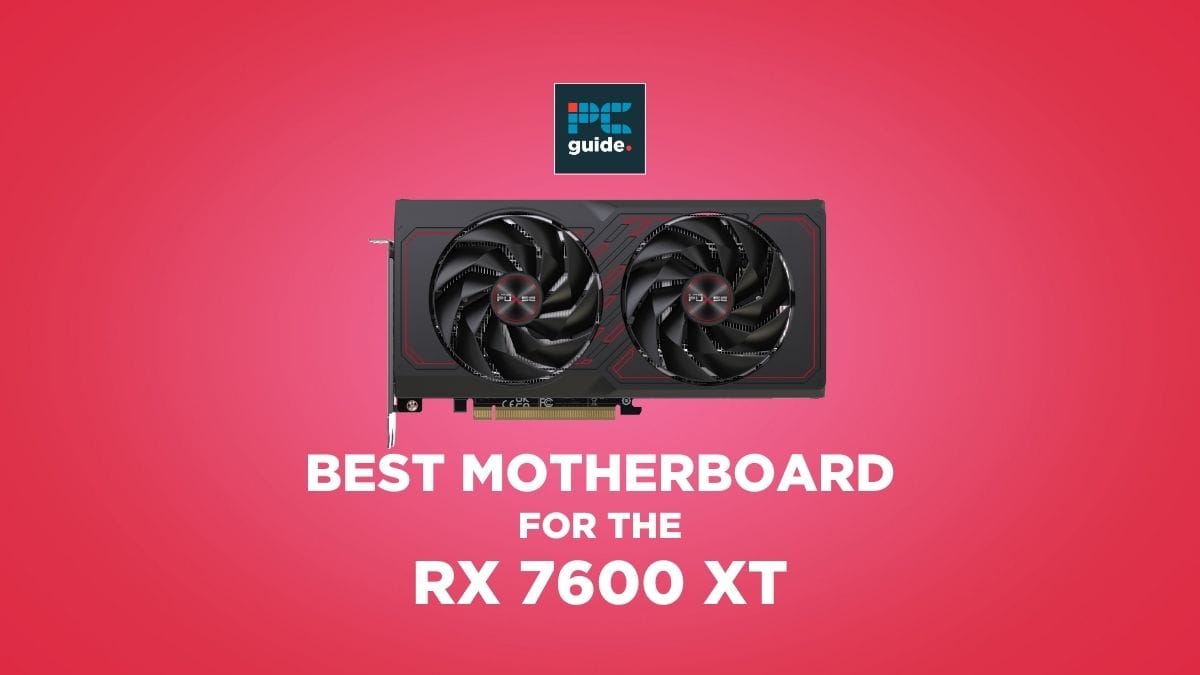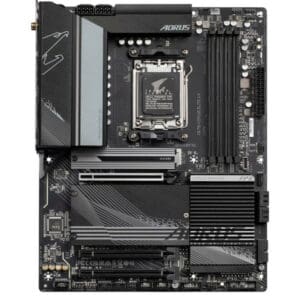Best motherboard for the RX 7600 XT

Table of Contents
To have a PC running perfectly, you need to match the GPU with the perfect motherboard. This guide will show you the best motherboard for the RX 7600 XT. To be as comprehensive as possible, we have included options for everyone – including both high-end users and budget-conscious ones.
Products at a Glance
How we picked the best motherboard for the RX 7600 XT
Our selection process for the best motherboards compatible with the RX 7600 XT is thorough and considers various aspects to ensure you get the most suitable options. First and foremost, we delve into publicly available benchmarks and user reviews to gauge the performance and reliability of different motherboards.
Another vital aspect of our selection process is evaluating the feature set of each motherboard. This includes assessing the quality and number of available ports, compatibility with various RAM types and speeds, and the ease of BIOS updates and overclocking capabilities. We also factor in user experience elements, such as the simplicity of the installation process, the clarity of the instruction manual, and the quality of customer support provided by the manufacturer.
For more articles on the RX 7600 XT, be sure to check out the in-depth breakdown of the product and how it compares to the RX 6700 XT. Anyway, let’s get to it.
Product Reviews
- Reliable power delivery system
- Sweet price point
- Solid connectivity options
- Limited RGB customization
- Overclocking capabilities could be better
If you want a balanced computer that can create the best performance in gaming as well as overclocking, the Asus Prime X670E-Pro WiFi is the best option. This well-priced motherboard is crafted with quality materials and stands out with its impressive technical specifications. These include an AMD AM5 socket ready for Ryzen 7000 Series processors, DDR5 RAM technology, and a high memory clock speed of 6400 MHz. Its chipset, the AMD X670, is known for its efficiency and reliability, making it a great fit for personal computers running on Windows platforms.
The ASUS Prime X670E-Pro WiFi shines in providing a stable power delivery with its 14+2 teamed power stages, ProCool sockets, and durable capacitors. Its next-gen connectivity options, including PCIe 5.0 and USB 3.2 Gen 2×2 Type-C, cater to users who demand high-speed data transfer and expansion capabilities. For gamers and professionals alike, the addition of Realtek 2.5 Gb Ethernet, WiFi 6E, and comprehensive cooling solutions ensures peak performance under demanding workloads.
- PCIe 5.0 and DDR5 support
- Solid power delivery
- Better suited for gaming
- Higher power consumption
- Complex BIOS for beginners
- Limited USB ports
For gamers, connectivity and speed are essential. With the Gigabyte X670 Aorus Elite AX, you get exactly this. This motherboard is tailored for the AMD Ryzen 7000 Series processors and supports DDR5 memory, ensuring you are at the cutting edge of technology. Its chipset, the AMD X670, along with a memory clock speed of 6666 MHz, ensures that you’re not just keeping up, but staying ahead in the game. Its 64 GB memory storage capacity and compatibility with the Windows platform make it an excellent choice for a wide range of personal computing needs.
The GIGABYTE X670 AORUS Elite AX stands out with its commanding power design, featuring a Direct 16+2+2 Phases Digital VRM Solution and an 8-layer 2X copper PCB for robust power management. The cutting-edge thermal design, including M.2 Thermal Guard and Ultra Durable Armor, ensures that your system remains cool and stable even under intense gaming sessions.
- Excellent rear I/O connectivity options
- Robust 21-phase power delivery system
- No PCIe 5.0 M.2 slots
- Premium price tag
MSI is renowned for crafting high-end motherboards, and the MSI MPG Z790 Carbon WiFi is a testament to their expertise in this domain. This motherboard is designed to support 12th and 13th Gen Intel Core, Pentium Gold, and Celeron processors, making it a versatile choice for various setups. It stands out with its support for DDR5 memory, reaching speeds up to 7600+(OC) MHz, which will help users looking to maximize their system’s performance.
The power design of the MSI MPG Z790 Carbon WiFi is nothing short of impressive, featuring a robust 19+1+1 phases power system, Core Boost, and Memory Boost. These features ensure stable and efficient power delivery to the system’s critical components, enhancing overall performance and reliability.
- PCIe 5.0 x16 slot
- Decent VRM design and solid heat sinks
- Good value
- Limited to DDR4
- Basic audio features
- Fewer USB ports
MSI also excels in offering budget-friendly motherboards without compromising on quality, and the MSI MAG B760 Tomahawk WiFi is a prime example. This motherboard supports 12th and 13th Gen Intel Core, Pentium Gold, and Celeron Processors, making it a versatile choice for various personal computing needs. It supports DDR4 memory, capable of reaching speeds up to 5333+(OC) MHz. Overall, offering a balance between performance and affordability.
The motherboard also features a PCIe 5.0 x16 slot, Lightning Gen 4 x4 M.2, and USB 3.2 Gen 2×2, which are impressive for a budget board, providing users with fast gaming experiences and quick data transfer options. The thermal solution on the MSI MAG B760 Tomahawk WiFi is commendable. The extended heatsink design and M.2 Shield Frozr ensure that the motherboard can handle high-performance tasks without overheating, making it suitable for continuous work or gaming sessions.
Features and considerations
The most important factor when picking the best motherboard for the RX 7600 XT will be its chipset and socket type, which must align with the GPU for seamless integration. Another key aspect is the number of PCIe slots. The RX 7600 XT, being a powerful GPU, will benefit from a motherboard with ample PCIe 4.0 slots, offering high-speed connectivity and future-proofing your setup.
Apart from the technical specifications, the choice of motherboard also depends on each user’s specific needs. High-end users might lean towards motherboards with additional features like built-in Wi-Fi, superior audio quality, and more USB ports for greater connectivity. Budget-conscious buyers, on the other hand, should focus on motherboards that offer the essential features without the extra frills.
How much power does Radeon 7600 XT use?
The Radeon 7600 XT typically consumes about 190 watts of power during regular desktop use. This moderate power draw makes it a good choice for those seeking efficiency in their gaming or work setups. To support this GPU, it’s recommended to use a PSU with at least a 600-watt capacity.
Our Verdict
Each of the motherboards we have reviewed here offers distinct advantages for different users. The ASUS Prime X670E-Pro WiFi is an excellent all-rounder, offering the best overall capabilities, balancing performance and connectivity at a reasonable price. The GIGABYTE X670 AORUS Elite AX stands out for its gaming-centric features and robust power delivery. While for high-end enthusiasts, the MSI MPG Z790 Carbon WiFi is the go-to with its superior power phases and DDR5 support. Lastly, the MSI MAG B760 Tomahawk WiFi provides great value for budget-conscious users, offering solid performance and PCIe 5.0 support at an affordable price. Which will you choose?






